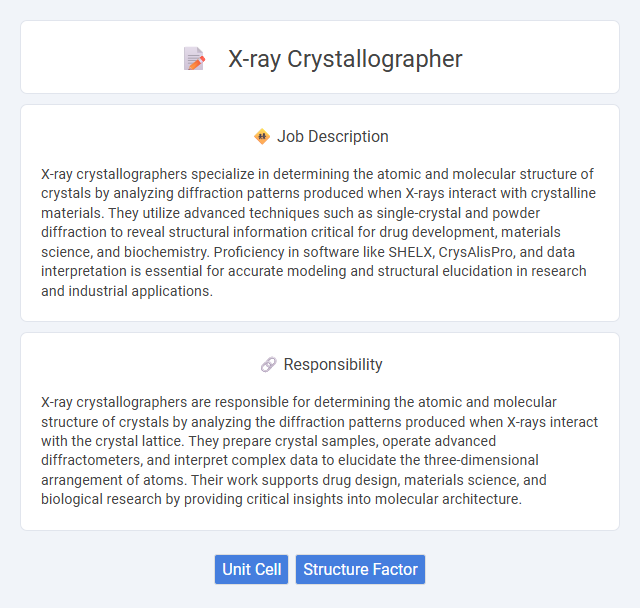
X-ray crystallographers specialize in determining the atomic and molecular structure of crystals by analyzing diffraction patterns produced when X-rays interact with crystalline materials. They utilize advanced techniques such as single-crystal and powder diffraction to reveal structural information critical for drug development, materials science, and biochemistry. Proficiency in software like SHELX, CrysAlisPro, and data interpretation is essential for accurate modeling and structural elucidation in research and industrial applications.
Individuals with strong attention to detail and a passion for scientific research are likely to find a career as an X-ray crystallographer suitable. Those who prefer structured laboratory environments and enjoy working with complex data may have a higher probability of success and job satisfaction in this field. People who struggle with patience or meticulous processes might find the role challenging due to the precision required in crystallographic analysis.
Qualification
X-ray crystallographers require a strong background in chemistry, physics, or materials science, typically holding at least a master's degree or PhD in these fields. Proficiency in operating X-ray diffraction equipment and expertise in interpreting diffraction patterns and crystallographic data are essential skills. Experience with software tools such as SHELX, CrysAlisPro, or Olex2 significantly enhances a candidate's qualifications for this specialized role.
Responsibility
X-ray crystallographers are responsible for determining the atomic and molecular structure of crystals by analyzing the diffraction patterns produced when X-rays interact with the crystal lattice. They prepare crystal samples, operate advanced diffractometers, and interpret complex data to elucidate the three-dimensional arrangement of atoms. Their work supports drug design, materials science, and biological research by providing critical insights into molecular architecture.
Benefit
X-ray crystallographers likely enjoy significant benefits such as contributing to groundbreaking discoveries in drug development and material science, which could enhance their professional reputation and job satisfaction. They probably have access to advanced technology and laboratory resources, potentially providing a stimulating and innovative work environment. Competitive salaries and opportunities for collaboration with interdisciplinary teams might also be common advantages in this specialized field.
Challenge
Working as an X-ray crystallographer may involve challenges such as accurately interpreting complex diffraction patterns and overcoming difficulties in growing high-quality crystals. The probability of encountering setbacks during data collection or analysis could be significant, demanding strong problem-solving skills and perseverance. Success often depends on meticulously optimizing experimental conditions and employing advanced software tools to resolve intricate structural details.
Career Advancement
X-ray crystallographers advance their careers by mastering techniques in protein structure analysis, contributing to drug design and material science breakthroughs. Specialized skills in crystallographic software like CrysAlisPro and Phenix enhance job prospects and promotion potential. Securing leadership roles often involves publishing in high-impact journals and collaborating with interdisciplinary research teams.
Key Terms
Unit Cell
X-ray crystallographers analyze the unit cell to determine the precise arrangement of atoms in a crystal by interpreting diffraction patterns. The unit cell, a fundamental repeating structure in the crystal lattice, defines lattice parameters such as edge lengths and angles, which are crucial for modeling molecular geometry. Accurate measurement and refinement of the unit cell contribute to understanding material properties and guiding drug design in pharmaceutical research.
Structure Factor
X-ray crystallographers analyze diffraction patterns to calculate the Structure Factor, a critical mathematical function representing the amplitude and phase of scattered X-rays from a crystal lattice. Accurate determination of the Structure Factor enables precise modeling of electron density maps, facilitating the identification of molecular structures at the atomic level. Expertise in computational algorithms and software tools such as Fourier transforms is essential for interpreting Structure Factor data in structural biology and materials science.
 kuljobs.com
kuljobs.com